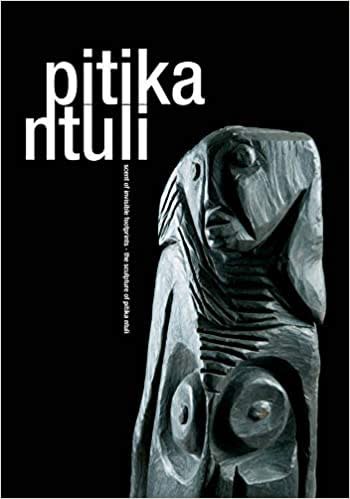About the book
Scent of Invisible Footprints intermingles poetry, prose and sculpture and gives the reader a glimpse into the complex and restless mind of Pitika Ntuli who spent 32 years of his life in exile. Pitika carries us into the world of wood, stone, bone and metal – turning the familiar into novelty; demystifying daily objects; powerfully conveying human feeling and sensibilities – ideas, philosophies and dreams ooze out of solid, apparently inanimate, objects. His works are full of humour, wit and magic, and are imbued with profound indigenous insights, whilst at the same time conversing with Western artists like Modigliani, Giacometti and Picasso. To read the book is to follow the scent of invisible footprints into the womb of this extraordinary sculptor’s creative mind.
Is it foolishness, obstinacy, foolhardiness,or is it crass perversity to continue to carve a delicate bone piece for hours and hours,for months on end, knowing that it could break into pieces at anytime? Is the agony of the thought, the ecstasy of achieving an accomplished work of Art, as a step toward creating the ultimate masterpiece, worth it?’. Pitika Ntuli
It is this context that highlights the significance for South Africa of a retrospective exhibition of Pitika Ntuli’s art. Pitika’s work is in various media, and the beauty, diversity and complexity of form reflect the combination of an extraordinarily unique creativity, a powerful intellect and a profound spirituality. Pitika sculpts in five main media: found objects (metal and plastic); stone; bone and wood.
Pitika Ntuli has exhibited in several individual and group exhibitions in many countries in Europe and in the USA, and has organised numerous international art and cultural events in Britain. His sculptures form part of several collections, and some of his public sculptures can be found in the Swaziland National Bank, Matsapa International Airport and St Mary’s Catholic Church in Lobamba. However, he has never exhibited in his own country, South Africa.
The massive retrospective of his sculpture, organised by Museum Africa, opened in mid-May 2010, and included works of found objects, bone, wood and stone, several of which echo the struggles of South African workers throughout recent history. The works represent the artist’s development over the last 45 years, although many of the sculptures have been created since his return to his native South Africa in 1994, and much of the collection in the last two years.
The catalogue includes photos of the sculptures, essays, poems and drawings. In addition, a small poetry volume of the artist’s poems is inserted in the back sleeve of the catalogue. The foreword is by MTN’s CEO and catalogue essays by Ali Khangela Hlongwane (Chief Curator, Museum Africa), Yonah Seleti (General Manager, NIKSO), James Swinson (Central St Martin’s School of Art, London), Ari Sitas ( Professor of Sociology (UCT) and Poet), Nalini Moodley (lecturer in Art, TUT), David Koloane (artist), and Antoinette Ntuli make this catalogue an inspiring read.
Contents
Foreword by Phuthuma Nhleko 105
CEO | MTN
Pre-Enable 105
‘It’s been a long journey’: the life and times of Pitika Ntuli Ali Khangela Hlongwane 008
Touching the Heart of Anguish: Pitika – Reflections and Reminders in the Mirror of Your Past Antoinette Ntuli 018
At The Nerve End of Our Dream James Swinson 098
Indigenous African Art & Healing: Forgotten Memories, Planting Memories of Tomorrow Pitika Ntuli 098
Explorations of Space and Time Nalini Naidoo 067
Poem Astrid von Kotze 178
Pitika Ntuli, magic, and the transmutation of objects David Koloane 189
The Backwards Flight of a Wily Entangler Ari Sitas 199
http://www.unisa.ac.za/default.asp?Cmd=ViewContent&ContentID=24253


